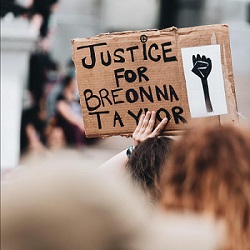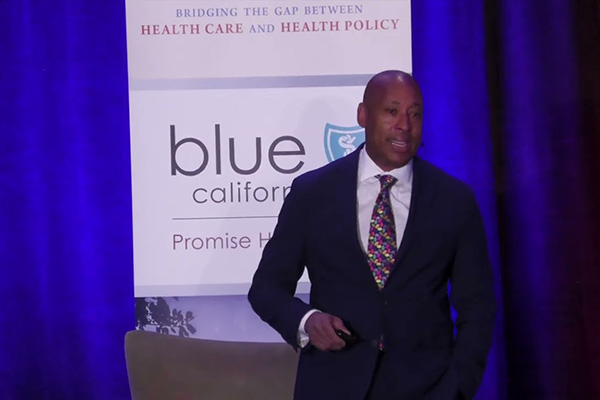Protecting Black Lives, and a Call for Solidarity + Action
The Cherished Futures team stands in solidarity in the fight against the perils of racism in its many forms, and we affirm our commitment to advancing system changes that protect Black lives.
Dear Cherished Futures Collaborative,
Our hearts and minds, along with many of you, have been grappling with pain and grief at the senseless deaths of George Floyd, Breonna Taylor, Ahmaud Arbery and the innumerable other Black individuals whose names did not make national headlines. The fight against the dehumanization and devaluation of Black lives dates back generations, and the call for justice and equity rings as true today as it did for our ancestors.
Both the COVID-19 pandemic and police violence have taken the lives of Black people at disproportionate and unjust rates; an inequity rooted in the structural racism woven into the fabric of our institutions and systems. The premature deaths of Black people have laid bare what researchers and public health experts have long known: racism is a public health crisis.
Dr. Barbara Ferrer, Director of the Los Angeles County Department of Public Health, and former Chair of the Public Health Alliance of Southern California recently stated:
“We know that black Americans fare worse than other groups on virtually every measure of health status and it has become all too common to blame this on individual behaviors when in fact the science is clear: The root cause of health inequities is racism and discrimination and how it limits access to the very opportunities and resources each of us needs for optimal health and well-being.”
The Impact of Trauma and Grief on Black Mothers’ Bodies
A powerful article published by Vox, highlights that Black mothers are living in an especially troublesome time — sandwiched between the current public health threat of COVID-19 and the longtime reality of police brutality, a double- bind of racism.
“As Black mothers, grief is embedded in our being. It accumulates and manifests as body aches and pains. But many of us have never been taught how to deal with it so it doesn’t become yet another risk to our health.”
This racialized stress, grief, and trauma contribute to the “weathering” or accelerated aging and deterioration of Black women’s bodies. A recent study published by researchers at Ohio State University noted that Black and Hispanic mothers exist in a state of “high alert to the possibility that their child will encounter unfair treatment.” The potential consequences of this stress are factors like slower blood pressure recovery, increases in inflammatory markers, and worse sleep patterns.
A Call for Transformative Solidarity: 3 Things Hospitals and Health Systems Can Do
In the midst of these difficult times, we need what Michael McAffee, President and CEO of PolicyLink calls “transformative solidarity.”
• How are you and your team taking a stand against racism?
• Let us know by responding to this article! We want to share your actions with others!
Here are 3 short-term actions providers, hospitals, and health systems can take to move towards solidarity and support our Black communities.
1. Stand Against Racism: Recommended Messaging for Taking a Stand
As shared by Cherished Futures Collaborative member, Dr. Melissa Franklin, organizations, and activists across the state have been taking a vocal stand against racism, and more are encouraged to do so.
Hospitals and health systems have spoken out about
racism and participated in the June 5th White Coats for Black Lives demonstration in honor of George Floyd.
Below are sample statements that can be
posted on your website and social media pages or can be customized and expounded to include action steps your hospital or
health system is taking to address racism. The important part is condemning racism and being willing to call out racism against Blacks/African Americans:
- We acknowledge the pain and suffering that anti-Black racism causes and continues to cause.
- We speak out against racism in all of its forms.
- We speak out against oppression.
- We speak out against the recent killings of unarmed Black
- We speak out against the recent killings of unarmed Black people, most recently Ahmaud Arbery, Breonna Taylor, and George Floyd.
- We stand in solidarity with those who pursue equity, justice, human dignity for all, and an end to racism.
For more inspiration, read Dr. Elaine Batchlor’s, CEO at Martin Luther King Jr. Community Hospital, powerful statement “It’s Time for a New Social Contract.”
2. Create Space for Dialogue at All Levels of Your Organization
Below is a sample letter shared by a physician champion in the Cherished Futures Collaborative. Consider creating a similar letter to be distributed in all departments at every level of your institution.
Dear Colleagues,
I’m sure many of you have been affected by national events sparking renewed discussion of structural and individual racism affecting Black Americans. The slayings of Ahmaud Arbery, Breonna Taylor, and George Floyd have occurred on a backdrop of health inequities, in which Black Americans are facing a disproportionate burden of disease in the COVID-19 pandemic. This itself occurs on a backdrop of long- standing health inequities, including higher maternal morbidity and mortality, higher burden of major chronic diseases, and shorter life expectancies.
In Medicine, it has never been possible to draw any boundaries between what is happening “out there” and our own practice. Disease, violence, the toxic and cumulative effects of hate and discrimination – these all bleed into our practice, sometimes literally. It’s incumbent on us, therefore, to show a high standard in addressing issues such as racism directly and boldly. To that end, we are offering a few opportunities and resources.
First, let’s gather and talk. While we are sending this message to our own department, it does not reach or include members of the Black community, who it affects the most, because we lack such representation here. Why we lack such diversity is a conversation to have, now. Why it’s important that we do is a conversation to have, now. And having the commitment to equity has to mean more than the occasional conversation here and there. So the conversation should be focused on how we move to action.
Second, let’s educate ourselves. We’re putting a short reading list below. These texts are foundational, not definitive; they will allow the start of productive conversations about how to address racism. The “advanced courses” on racism actually occur in real life, as we grapple with how to combat it in our work and lives.
Third, let’s as an institution be the ones to reach out. Please know that our Black colleagues and trainees are suffering, not only because of the events and what they evoke, but because of the blithe silence of their colleagues and leadership. Reach out with a quick message of support. Do not ask for help or education; that responsibility is ours alone, and they do not need any additional burden. But let members of our community know they are seen, supported, and that their fight is our fight.
Sincerely yours,
XXXXSuggested Starting Reading List
• How to be Anti-Racist, Ibram X. Kendi
• So You Want to Talk About Race, Ijeoma Olou
• White Fragility, Robin DiAngelo
• Between the World and Me, Ta-Nehisi Coates
3. Strengthen Community Partnerships and Communication
The Institute for Diversity and Health Equity an affiliate of the American Hospital Association, highlights that some hospitals and health systems are working with trusted partners such as faith-based organizations and other community-based organizations, to expand their reach into neighborhoods most impacted by inequities, particularly in the midst of COVID-19.
The Cherished Futures and African American Infant and Maternal Mortality (AAIMM) networks can help strengthen the communication channels between hospitals, providers, and the Black birthing families they serve. Visit
www.blackinfantsandfamilies.org to stay connected to the birth equity work happening throughout Los Angeles County.
About Cherished Futures for Black Moms & Babies
Cherished Futures for Black Moms & Babies (Cherished Futures), an initiative led by the Hospital Association of Southern California, Communities Lifting Communities, and the Public Health Alliance of Southern California, is a multi-sector collaborative that aims to reduce Black infant mortality and improve patient experience and safety for Black mothers and birthing people in South Los Angeles, South Bay, and the Antelope Valley. Guided by the data and grounded in Black women’s experiences, Cherished Futures brings together decisionmakers from local birthing hospitals, public health departments, health plans, and Black women from the priority communities to co-design systems-change solutions at the clinical, institutional, and community levels.





